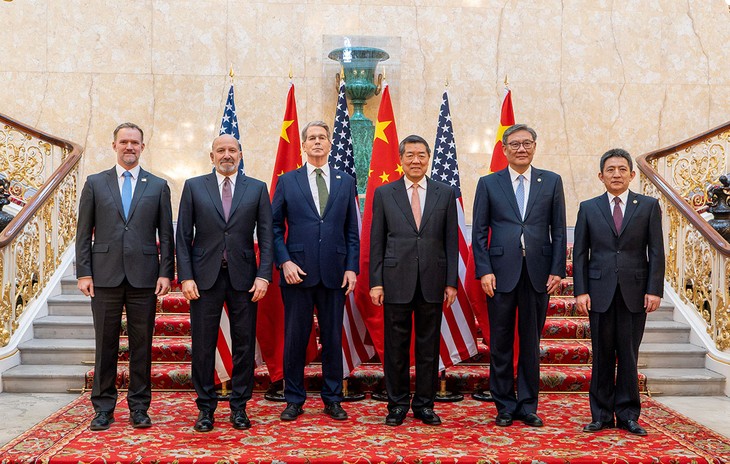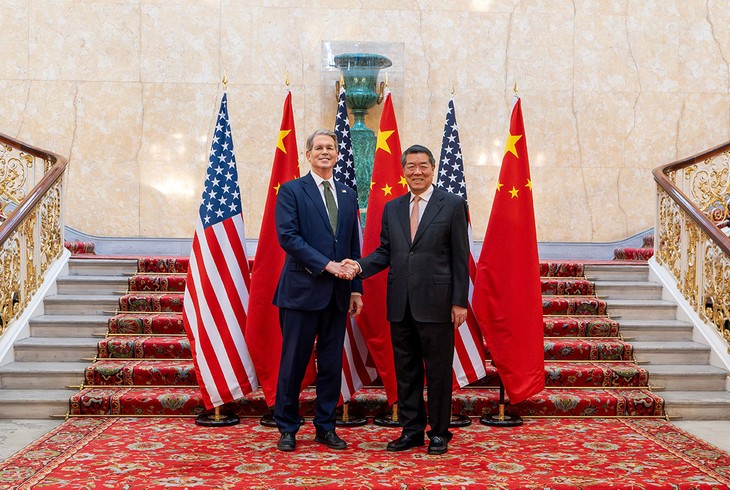(VOVWORLD) - Top economic officials of the US and China began a new round of trade talks in London on Monday, aiming to resolve tensions. The talks follow a meeting in Geneva on May 12, where both sides agreed to a temporary tariff truce.
 The US and Chinese delegation at the trade talks in London on June 9, 2025. (Photo: United States Treasury/Handout via REUTERS) The US and Chinese delegation at the trade talks in London on June 9, 2025. (Photo: United States Treasury/Handout via REUTERS) |
The negotiations began four days after a phone conversation between President Donald Trump and President Xi Jinping, who expressed their desire to improve bilateral trade relations.
Goodwill from both sides
The negotiations, taking place at Lancaster House in London, mark the first use of their bilateral trade and economic consultation mechanism since their Geneva meeting last month. The Chinese delegation is led by Vice Premier He Lifeng. The US side includes Treasury Secretary Scott Bessent, Commerce Secretary Howard Lutnick, and Trade Representative Jamieson Greer.
The aim of the talks is to maintain and advance the Geneva truce in which the two sides agreed on a 90-day tariff pause. Observers have particularly noted the presence of Howard Lutnick, who was absent from the Geneva round, because his Commerce Department is responsible for imposing export restrictions on China. His direct involvement this time suggests that two key issues will be China’s rare earth exports to the US and US semiconductor exports to China.
After the first day of talks, President Trump said: “We want to open up China. And if we don't open up China, maybe we won't do anything, but we want to open up China. It'll be a great thing for China, great thing for the rest of the world."
Experts say that, despite their slowness in resolving their trade disagreements, Washington and Beijing are both aware that the current situation benefits no one. Kent Kedl, founder of Shanghai-based consultancy Blue Ocean, said: “What trade deals need is a normal conversation. They need a situation to sit down and go, all right, folks, this is about the numbers, this is what we need, this is what you need. Let's find a way to get to that point. So it is on the way to something bigger because both sides know that they need something bigger. I think it is in the plan and in the strategy for both sides that they need a deal. It can't continue like it has been.”
 Chinese Vice Premier He Lifeng (R) and US Treasury Secretary Scott Bessent (Photo: US Treasury/Handout via REUTERS) Chinese Vice Premier He Lifeng (R) and US Treasury Secretary Scott Bessent (Photo: US Treasury/Handout via REUTERS) |
Economic losses
Global investors are watching the London talks closely, as newly released data show that US–China trade tensions are beginning to have a negative effect, not only on their two economies, but on the global economy as well.
Chinese customs reported Monday that China’s exports to the US in May dropped 34.5%, the steepest decline since February 2020 when the COVID-19 pandemic disrupted global trade. China’s imports from the US fell 18%. Although this was a slower pace than in April, the year-on-year decrease is significant.
Inflation in the US is still under control and the US labor market is stable, but the tariff confusion is starting to have an impact. Many US firms, especially in the retail sector, have already lost tens of billions of dollars due to suspended exports to China and rising domestic prices.
Eric Zheng, President of the American Chamber of Commerce in Shanghai (AmCham Shanghai), said: “The current tariff levels are too high for our companies. Because our companies continue to import inputs from the US and also export some products to the US. The tariffs are prohibited our companies to continue. We are hoping that the two governments could sort out their differences. So that they could reach that sort of a agreement to lower the tariffs.”
Beyond US and Chinese firms, companies worldwide are hoping for progress in US–China trade ties. Recently, several industry groups, including the German Association of the Automotive Industry (VDA), the US Alliance for Automotive Innovation, and India’s Bajaj Auto, have warned that China’s tighter controls on rare earth exports could disrupt or even paralyze auto manufacturing in many countries, not just in the US. Other sectors like electronics, aviation, and defense are also predicted to be severely impacted by ongoing export restrictions from both countries.